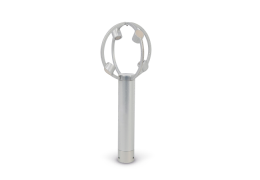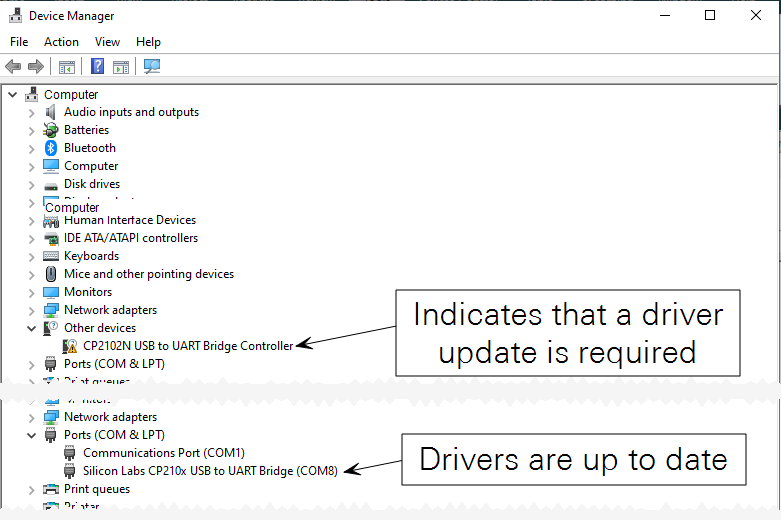Troubleshooting
The sensor seems unresponsive
- Can you hear the transducers?
- In a quiet room, hold the LI-560 close to your ear and listen for a faint clicking sound. Absence of sound alone is not an indicator of an issue because differences in auditory sensitivity and background noise may make the sound difficult to hear. However, if you hear the clicking sound, the anemometer is working correctly. If you do not hear a sound, continue with the next steps.
- Is the power supply working and wired correctly?
- Use a volt meter to measure power at the source and at any connections. The LI-560 requires 5 - 32 VDC (12 volts is ideal). Be sure the power supply wires are not shorted, and be sure that terminals are clamped onto wire rather than the insulation. See Support: LI-560 TriSonica® Sphere Ultrasonic Anemometer.
- If using the USB adapter, is the USB port providing power?
- Remove the cover on the USB adapter. If it is plugged in to a powered USB port, two LEDs on the board will be illuminated, indicating power in and power out. (If desired, use a volt meter to measure voltage at the terminal connection. The USB adapter should be receiving around 5 volts from the power supply and delivering around 12 (±0.75) volts to the anemometer.) Be sure that terminals are clamped onto wire rather than the insulation.
- Are the RX and TX data wires connected correctly?
- Be sure that there are no shorted contacts and that the data connections are correct. Be sure that terminals are clamped onto wire rather than the insulation. See Connecting the power and data cable.
- Correct COM port assigned to the USB adapter?
- To find the serial port number, open the Device Manager (press the Windows key
 , type Device Manager, then press Enter). Click Ports (COM & LPT). Look for USB Serial Port (COM#). The serial port numbers are shown beside the ports. The COM port must be the same as the one selected in the TriSonica application.
, type Device Manager, then press Enter). Click Ports (COM & LPT). Look for USB Serial Port (COM#). The serial port numbers are shown beside the ports. The COM port must be the same as the one selected in the TriSonica application.
- Data visible in a terminal program?
- The presence of data indicates that the anemometer is working properly. See Serial communication settings for details.
If you’ve followed these steps and you are unable to view data, contact us at envsupport@licor.com for further steps.
Connection issues, no serial data, or the connection fails
If you are unable to connect to the device, stream data, or if you experience connection failures:
- Are the RX and TX data wires connected correctly?
- Be sure that there are no shorted contacts and that the data connections are correct. Be sure that the RX and TX wires are not swapped. Check that the terminals are clamped onto wire rather than the insulation. See Support: LI-560 TriSonica® Sphere Ultrasonic Anemometer.
- Correct device drivers?
- Sometimes the Windows Operating System does not have the necessary device driver. To check, open your Device Manager (press the Windows key
 , type Device Manager, then press Enter).
, type Device Manager, then press Enter).
- To update the driver:
-
- Go to silabs.com/developers/usb-to-uart-bridge-vcp-drivers and download the file called CP210x Universal Windows Driver.
- Extract files from the compressed folder; save them to your downloads folder.
- From the Device Manager, right click CP2102N USB to UART Bridge Controller, select Update Driver, and then select Browse my computer for drivers.
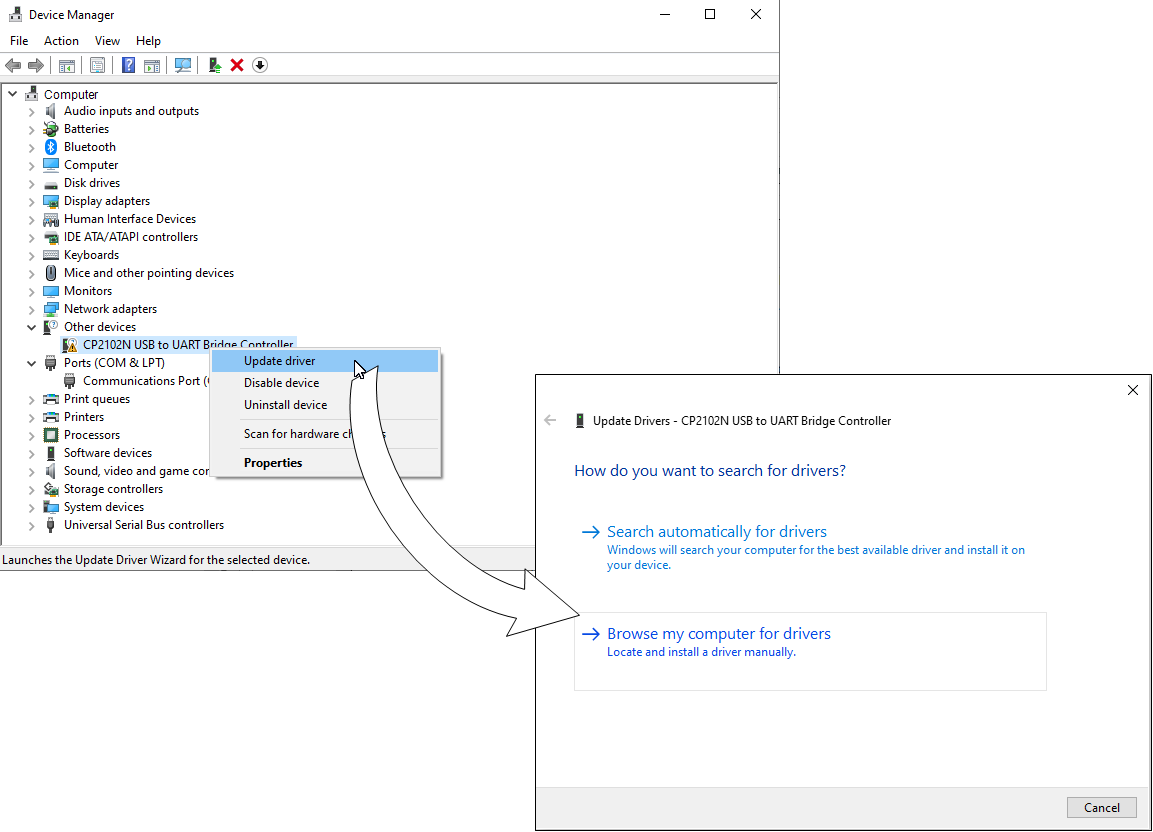
- Select the folder that has the extracted driver files and click through the prompts.
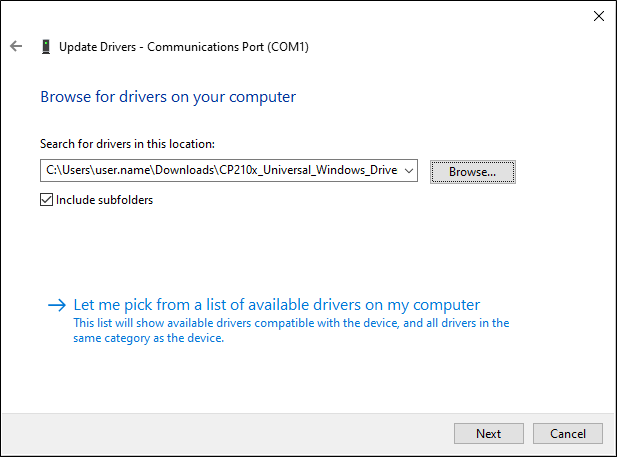
- Your computer will install drivers and the USB adapter will be moved to the list of Ports (COM & LPT), and be assigned a COM port number. Now you should be able to connect using the assigned COM port number.
If you've followed these steps and you are unable to connect, contact us at envsupport@licor.com for further steps.
Unexpected readings or errors
Unexpected readings and errors may indicate a wiring or configuration issue.
- Unexpected offsets in tilt reading?
- Check the calibration of the digital level. If multiple anemometers are used together, calibrate them together to achieve consistency between them. See User calibration for details on these procedures.
- Temperature data noticeably different from expected?
- If the LI-560 sensor has been dropped or knocked about, or has become skewed during installation, the distance between transducers may have changed slightly from what was calibrated at the factory. Re-calibrate your sensor to the new distances by following the instructions User calibration.
- Blocked sonic path (values of -99.xx in the data stream)?
- If one or more paths between transducers is blocked, the anemometer will report an error message. Ice, snow, or some other physical material is preventing the ultrasonic signal reception. Clearing the blockage returns the unit to normal operation. Use the diagnostic command to get information about the error (see Diagnostic for more details).
- Calibration returning unreasonable values?
- If the values of wind speed or temperature are very different from the values entered into the calibrate command, it is possible that the current distance and offset values are outside the allowable range for the calibration algorithm. Enter expert mode and set the distance of all paths to 0.060 with the command distance 0.060 and the offset to zero with offset 0. Then try the calibrate command.
- Correct serial port settings?
- Check the baud rate and parity settings on the receiving unit or computer. The LI-560 default transmission settings are Baud Rate: 115,200, Data Bits: 8, Parity: None, Stop Bits: 1. In Tera Term, the serial connection settings are configured under Setup > Serial port.
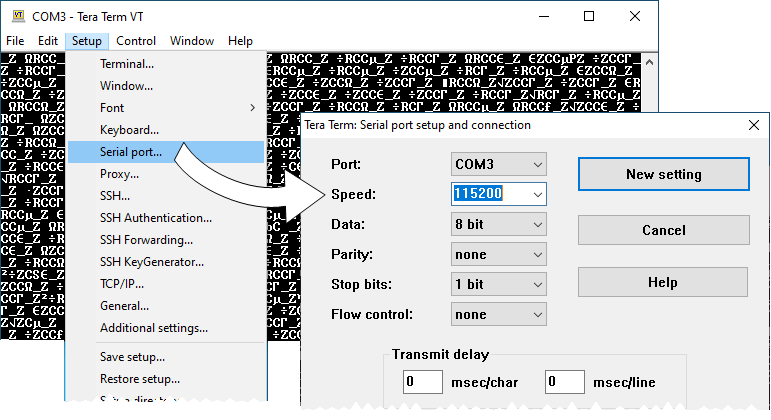
- Is the power supply working and wired correctly?
- If the data still do not make sense or are all 99s, check the power supply and receiving unit (e.g., data logger) to make sure there is a ground connection between the power supply, the serial port receiving data, and the LI-560.
- Power supply transient or variation?
- On rare occasions, a large deviation in the power supply voltage can lead to unexpected performance. Restart the device to resolve the issue.
If you've followed these steps and you are still observing errors, contact us at envsupport@licor.com for further steps.
